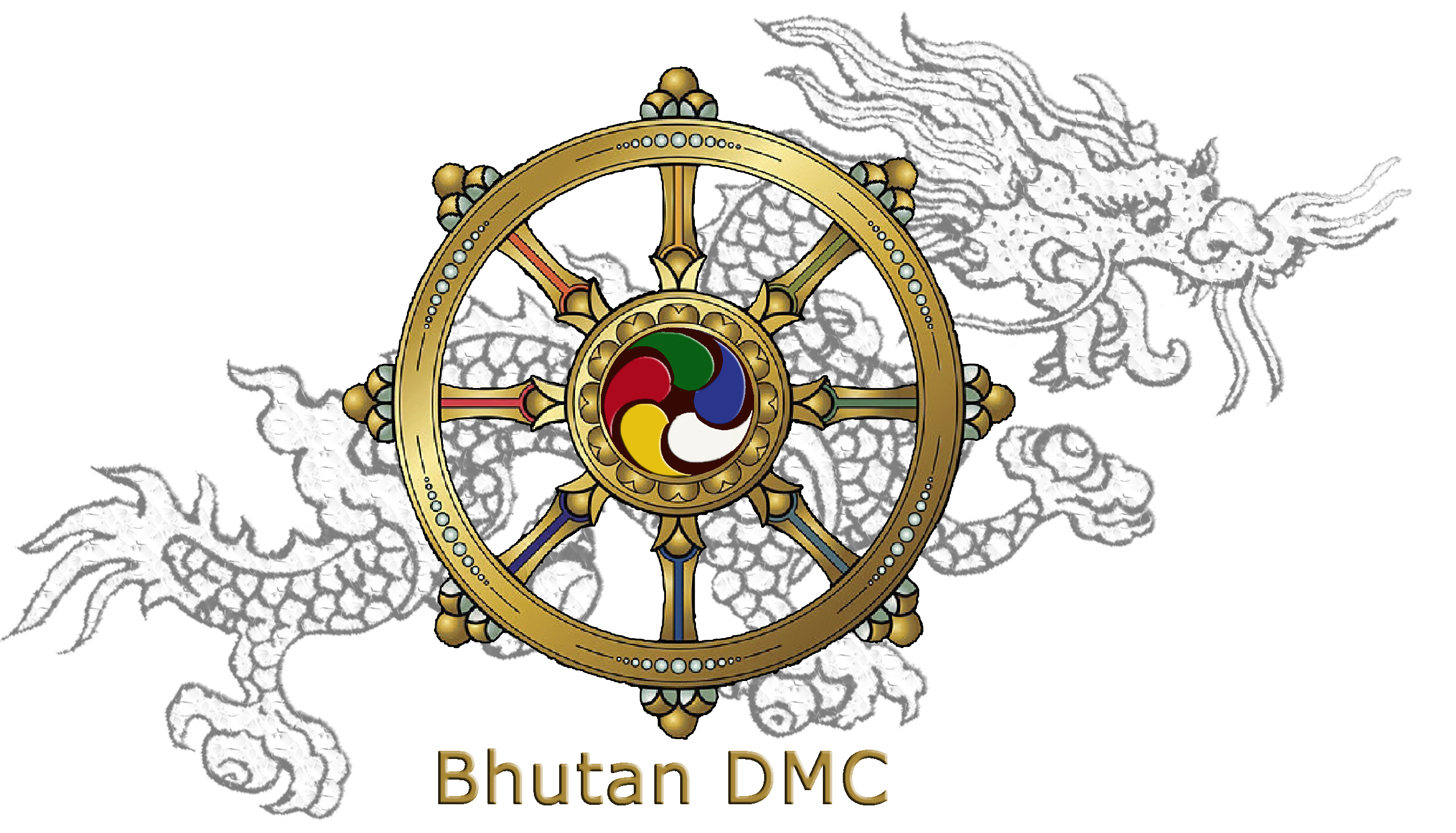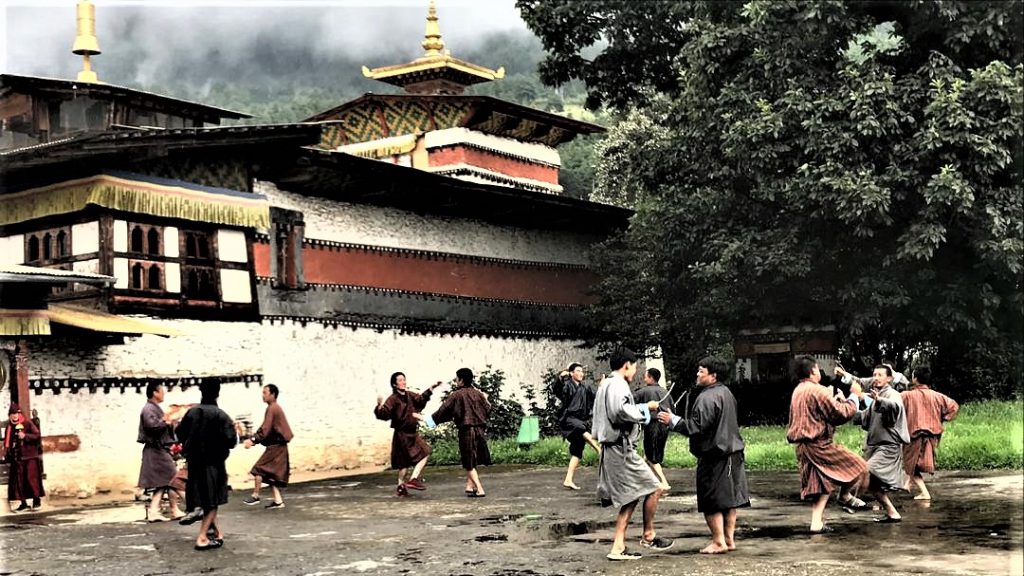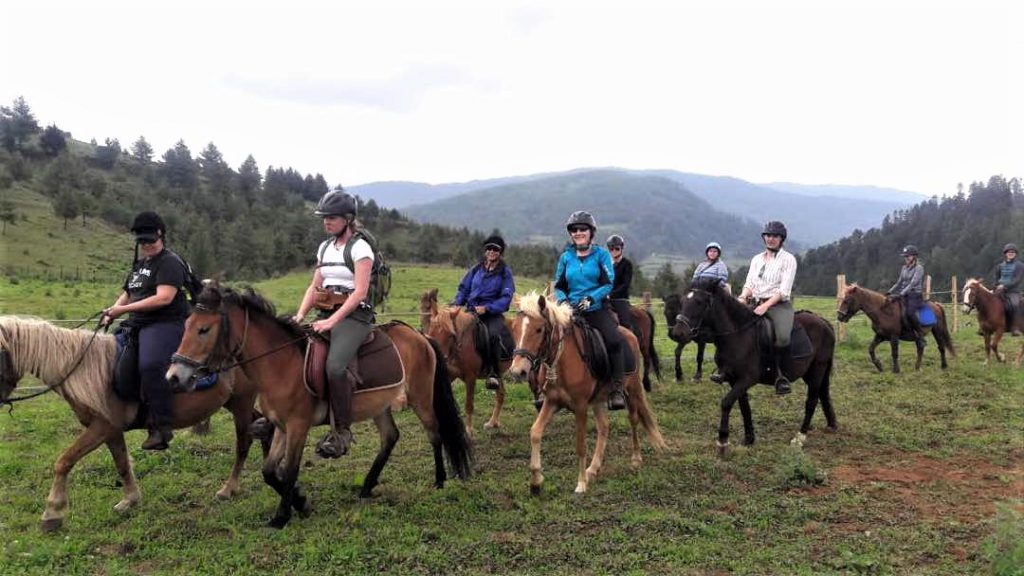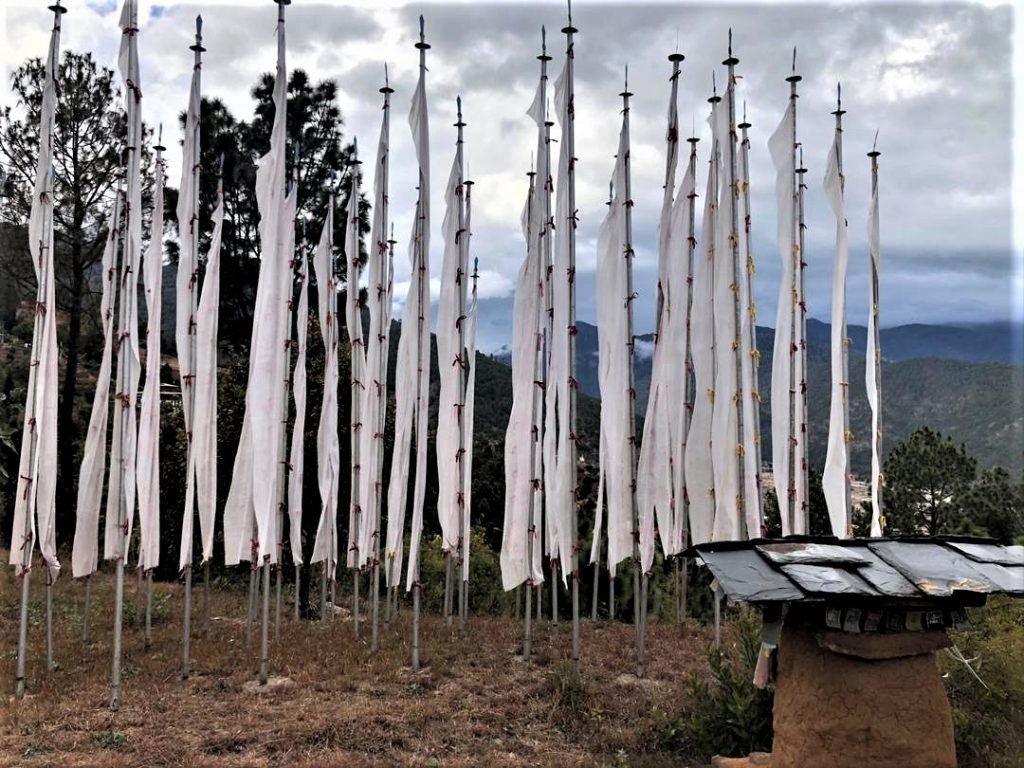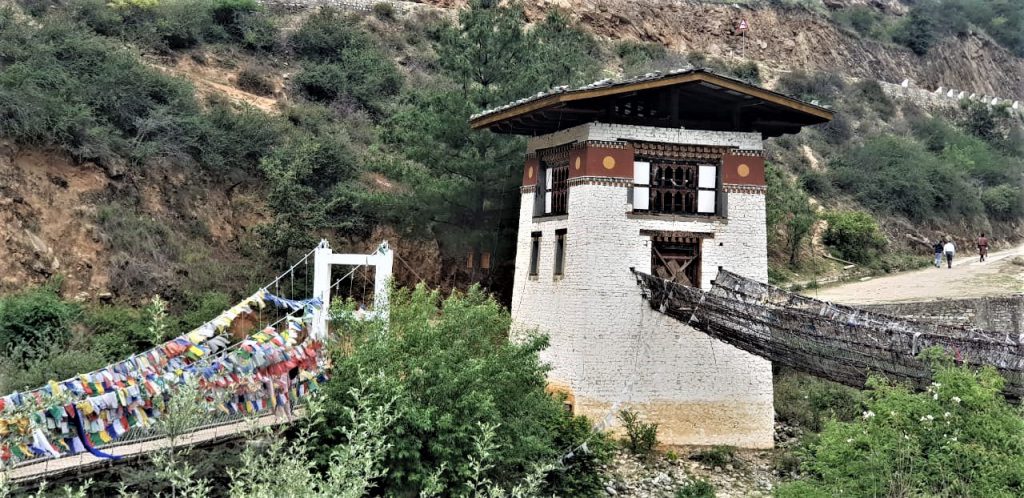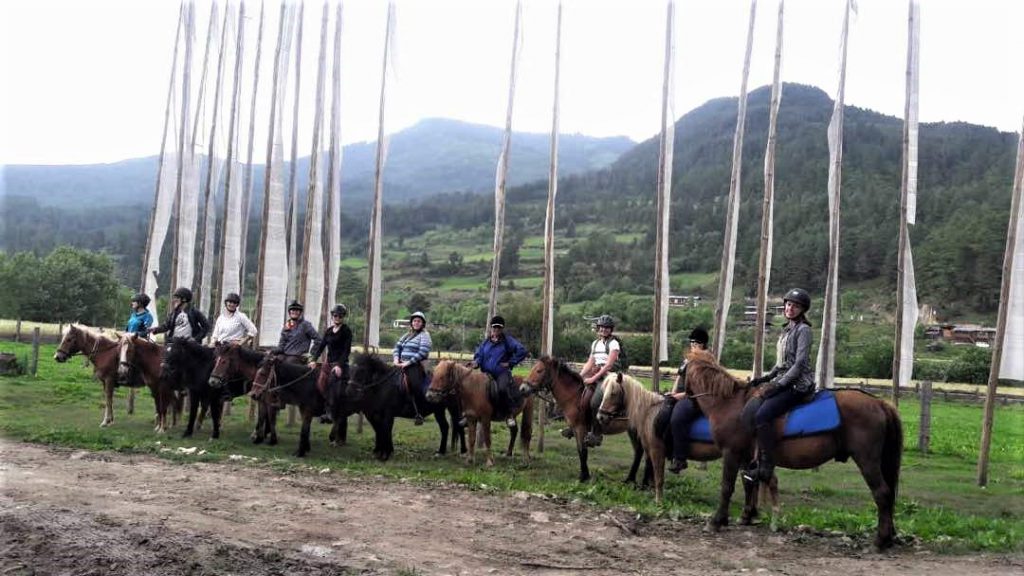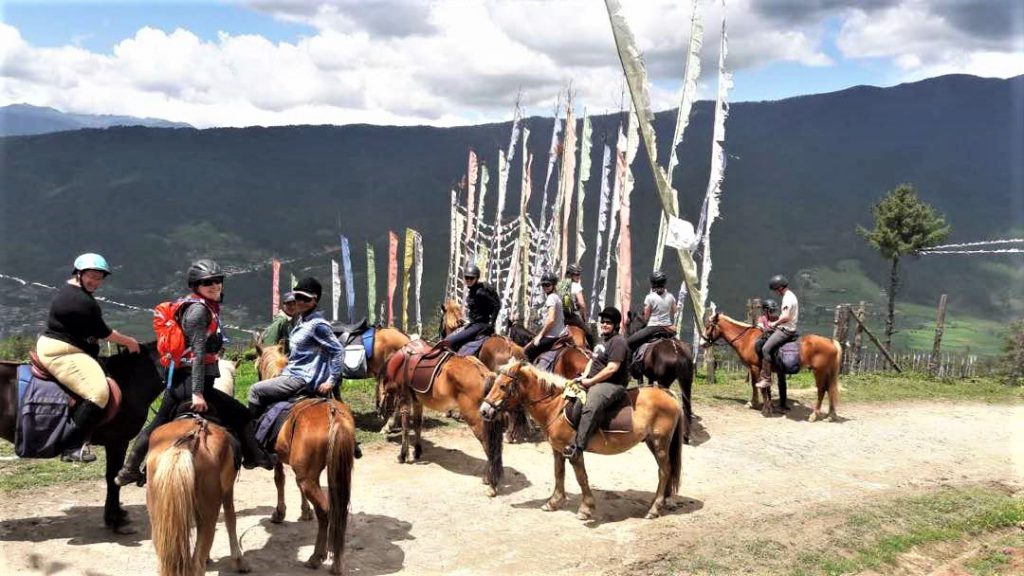Mountainous terrains of Bhutan offer enthralling adventure on horsebacks. You will relish every moment. The itinerary entails road travel through prominent cultural destinations of western & central Bhutan and three days of horse ride in the kingdom’s most beautiful valleys, Bumthang, following the Royal trail and en-route visiting Ugencholing Palace, Villages, Farmhouse, ancient temples, monasteries, and of course plethora of flora and fauna.
Day 1
Arrive Paro (Bhutan) by Flight & transfer to Thimphu (55km, approx. 1.1/2-hour drive)
The flight to Paro is one of the most spectacular in entire Himalayas. Whether flying along the Himalayan range from Kathmandu or over the foothills from Kolkatta, the journey offers fascinating views and an exciting descent into the Kingdom. Bhutan’s first gift to you as you disembark from the aircraft will be cool, clean fresh mountain air. After immigration formalities and baggage collection, you will be met by our representative, and afterwards drive to Thimphu, the capital town of Bhutan with en-route stop at Chuzom, the confluence of Thimphu and Paro rivers. Three different style of stupas; Tibetan, Nepalese and Bhutanese adorn this confluence.
Shortly before reaching Chuzom, you will see on your left Tamchog Lhakhang, the temple built by Thangtong Gyalpo, a pioneering engineer who introduced the construction of suspension bridges into Bhutan and Tibet (several of which are still in use today). The present bridge to Tamchog Lhakhang was restored in 2005 in the design of a traditional style with iron chains and crossing this iron bridge is a wonderful experience. (approx. 50 min, roundtrip walk).
On arrival in Thimphu, check into the hotel.
Later drive to visit Buddha Point (Kuensel Phodrang). Located at a short drive from Thimphu city centre, visitors can get a good overview of the Thimphu valley from the Buddha point (Kuensel Phodrang). You can pay your obeisance and offer prayers to the Buddha, the largest statue in the country and then walk around and take a glimpse of the valley.
Afterwards an exploratory walk around Thimphu main street and market area.
Overnight at the hotel in Thimphu. (Altitude 2320m)
Day 2
Thimphu
After breakfast, take a short drive (15 km) to Pangri Zampa, the 16th century monastery, located just north of Thimphu. It has a monastic school where Buddhist monks learn Lamaism and astrology based on Buddhist philosophy.
Then proceed for a tour of some of city’s main highlights:
National Library: The history of Bhutan lies imprinted in archaic texts, which are preserved at the National Library. Besides thousands of manuscripts and ancient texts, the library also has modern academic books and printing blocks for prayer flags.
Institute for Zorig Chusum: Commonly known as Arts & Crafts School or Painting School, the Institute offers a six-year course on the 13 traditional arts and crafts of Bhutan. On a visit, one can see students learning the various skills taught at the school.
Folk Heritage Museum: The Museum is dedicated to connecting people with the rich Bhutanese Folk heritage and rural history through exhibits, demonstrations, educational programs and documentation of Bhutanese rural life.
Afternoon a special visit to Textile Museum. The textile museum has opened its exhibition on six major themes – warp pattern weaves, weft pattern weaves, role of textiles in religion, achievements in textile arts, textiles from indigenous fibers and the royal collection. The crowns of Bhutan’s Kings, namzas (dresses), the first version of Royal Crown and other accessories used by members of Royal family can be found in the museum. A brief and simple talk on Bhutanese textiles weaving.
Then visit, Memorial Chorten: The stupa built in the memory of Bhutan’s third King, His Late Majesty, King Jigme Dorji Wangchuk, who is popularly regarded as Father of modern Bhutan. The paintings and statues inside the monument provide a deep insight into Buddhist philosophy.
Conclude the tour of the day with a visit of Trashichhoe Dzong, “fortress of the glorious religion”. This is the center of government and religion, site of monarch’s throne room and seat of Je Khenpo or Chief Abbot. Built in 1641 by the political and religious unifier of Bhutan, Shabdrung Ngawang Namgyal, it was reconstructed in 1960s in traditional Bhutanese manner, without nails or architectural plans.
Overnight at the hotel in Thimphu. (Altitude 2320m)
Day 3
Thimphu – Gangtey (150km, approx. 5-hour drive)
After breakfast drive up to Dochu-la pass (3,088m/ 10,130 ft) stopping briefly here to take in the view and admire the chorten, mani wall, and prayer flags which decorate the highest point on the road. If skies are clear, the following peaks can be seen from this pass (left to right): Masagang (7,158m), Tsendagang (6,960m), Terigang (7,060m), Jejegangphugang (7,158 m ), Kangphugang (7,170 m ), Zongphugang (7, 060 m ), a table mountain that dominates the isolated region of Lunana – finally Gangkar puensum, the highest peak in Bhutan at 7,497m.
At Dochula Pass, 108 chortens or stupas known as Druk Wangyal Chortens have been built by Ashi Dorji Wangmo Wangchuk, the eldest Queen Mother. These chortens are built in three layers, the first lowest level layer has forty-five chortens, the second has thirty-six and the top layer has twenty-seven, built around the main chorten.
Then explore some part of Royal Botanical Park. It is the first botanical park in Bhutan and forms the backdrop of the Dochula Pass.
Afterwards drive onto Wangdue, taking a short lunch stop in this town.
Then drive onto Gangtey, passing through dense forests of oak and rhododendron tress.
The valley of Gangtey is one of the most beautiful and unspoiled places in Bhutan. The surprise of finding such a wide, flat valley without any trees after the hard climb through dense forests is augmented by an impression of vast space and is an extremely rare experience in Bhutan where most of the valleys are tightly enclosed. A few kilometers beyond the Gangtey Monastery, on the valley floor lies the village of Phobjikha.
On arrival, check into the hotel.
Evening take a stroll in fascinating Phobjikha valley.
Overnight at the hotel in Gangtey. (Altitude 3000m)
Day 4
Gangtey
Early morning visit Monastic School to witness prayer ceremony.
Later after breakfast visit Gangtey Goempa (monastery), perched on a ridge overlooking the valley. It is directed by Gangtey Tulku, the ninth reincarnation (a “Tulku” is a reincarnate) of Pema Lingpa—a famous Buddhist saint and teacher.
Then a walking excursion to Gangtey Nature Trail. This pleasurable walk will give you a nice feel of Phobjikha valley. From the small hilltop overlooking Gangtey Goemba, you head downhill through flower meadows to Semchubara village and from here through beautiful forests and into the open valley. The trail ends at local community school after passing a chorten and Khewa Lhakhang. (approx. 5.5km, 2 hours walk).
Post lunch explore fascinating Phobjikha valley. This place is the winter home of black necked cranes that migrate from the arid plains in the north to pass winter in milder and lower climate. The valley boasts two beautiful meandering rivers, Nakay Chhu (Chhu Naap-black water) and Gay Chhu (Chhu Karp-white water).
Also visit Black Neck Crane Information Centre. Situated on the edge of the forest and wetland along the main road of Phobjikha valley, the black-necked crane information Centre has an observation room equipped with high power telescope and spotting scopes for catching the best view of the cranes. The centre also offers display information that outline the natural and cultural history of the area. There is a small gift shop, which sells handicrafts produced by the local people.
Overnight at the hotel in Gangtey (Altitude 3000m).
Day 5
Gangtey – Bumthang (Jakar) (153km, approx. 6-hour drive)
Morning after breakfast drive to Bumthang via Trongsa.
The drive to Trongsa crosses Pelela pass (3,300 m), the traditional boundary between east and west. The pass is marked by a large prayer flag and the ground is covered with high altitude dwarf bamboo. Stop en route at Chendbji Chorten, the stupa built in 18th century by a Lama named Shida. It is Nepalese in style with eyes painted at four cardinal points.
Trongsa town, perched on steep slopes above a river gorge, forms the central hub of the nation and is the place from where attempts at unifying the country were launched. The landscape around Trongsa is spectacular.
After lunch in Trongsa, proceed to visit Trongsa Dzong, built in 1648 it was the seat of power over central and eastern Bhutan. Both the first and second Kings of Bhutan ruled the country from this ancient seat.
Then continue drive to Bumthang across Yutong-la pass (3,400m/ 11,155 ft). The road winds steeply up to the pass from Trongsa, then runs down through coniferous forest into a wide, open cultivated valley known as the Chumey valley.
Take a short stop at Chumey, a wide fertile valley where wheat, barley, potatoes and buckwheat are cultivated. Chumey is particularly known for its famous wool weaving called ‘Bumthang Yathra’. Visit Yathra weaving centre, enjoying tea / coffee with weaving family.
On arrival in Bumthang, check in to the hotel.
Overnight at the hotel in Bumthang. (Altitude 2600m)
Day 6
Bumthang (Drive to Tang Valley, 2.1/2-hour drive)
Bumthang is the general name given to combination of four valleys – Chumey, Choekhor, Tang and Ura with altitude varying from 2,600m to 4,000m. It is home to many of prominent Buddhist temples and monasteries.
After breakfast, visit Jambey Lhakhang. This monastery was built in the 7th century by Tibetan King, Songtsen Gampo. It is one of the 108 monasteries built by him to subdue evil spirits in the Himalayan region. Its present architectural appearance dates from the early 20th century.
Then visit to Kurje Lhakhang, consisting of three temples. The one on the right was built in 1652 on the rack face where Guru meditated in the 8th century. Second temple is built on the site of a cave containing a rock with the imprint of Guru’s body and is therefore considered the most holy. The third temple was built in 1990s by Ashi Kesang, the Queen Mother. These three temples are surrounded by a 108 chorten wall.
Then drive about 2 ½ hrs to Tang Valley.
Upon reaching the valley floor, check into Ugen Chholing Manor Guest House. Tour Ugenchholing Manor and after lunch at the Guest house, ride to the nearby village to visit the local village, meet local etc. These rides will provide necessary familiarization and get acquainted with the horse etc. Guests can visit local village homes, interact with family etc.
Overnight at Guest House.
Day 7
Tang Valley – Kunzangdrak village (Horse Trekking)
Begin ride after breakfast. The ride takes around 5-6 hours, first passing through villages and then through the fields and forests. Lunch will be along the way. Camp near the Kunzang dra village.
There is a temple and hermitage on the cliff (Kunzangdra Monastery). It was founded by Pemalingpa in 1488 and is one of his residences with nice shrine.
Overnight in Camp.
Day 8
Kunzangdrak – Padselling Monastery (Horse Trekking)
Start your day with some fun exercises atop the horse that are beneficial to both you and your pony as you improve your riding balance and confidence. Begin your long ride through the forests and hillsides as you make your way towards the next camping site. Upon reaching the camping site, you will get the opportunity to explore a Buddhist Monastery, village and Temple atop the Mountainside, perfect for taking pictures. (Ride Duration Approximate 6 hours).
Overnight in Camp.
Day 9
Padselling – Dorjibi village – Jakar (Horse Trekking)
Enjoy a relaxing ride through the forests, hillsides and terrain as you make your way down the hill. You will be riding mostly on village roads and trails, making it easy to maneuver your pony. Advanced riders can participate in some trot as guided by the trail leader whereas beginners can practice their riding exercises. (Frogs/Up Downs) (Riding Duration Approximate 4- 5 hours). After visiting Dorjibi village, take a short drive to the hotel in Jakar.
Overnight at hotel in Bumthang. (Altitude 2600m)
Day 10
Bumthang – Punakha (215km, approx. 7 hours drive)
After breakfast visit to Jakar Dzong. Founded by great grandfather of the first Shabdrung, the Dzong was initially built as a monastery in 1549. It was upgraded after the Shabdrung had firmly established his power in 1646. The Dzong is now used as administrative centre for Bumthang valley and houses the regional monk body.
Then drive to Punakha.
Punakha served as the capital of Bhutan and seat of government until 1955 and still it is the winter seat of Je Khenpo (the chief abbot). Blessed with temperate climate and owing to its natural drainage from Pho Chhu (male) and Mo Chhu (female) rivers, the fertile Punakha valley produces abundant crops and fruits. Located at an elevation of 1300m above sea level, Punakha enjoys mild winters and is popular year-round destination.
En route visit Ta Dzong, recently opened fort in Trongsa. The Ta Dzong, a cylindrical stone structure rising five stories, was built in 1652 by Chogyal Minjur Tempa. After more than 350 years, it has been resurrected into a classy museum, that represents a tasteful blend of tradition and modernity.
On arrival in town, check into the hotel.
Overnight at Hotel in Punakha. (Altitude 1300m)
Day 11
Punakha
After breakfast, a beautiful hike takes one to the regal Khamsum Yuelley Namgel Chorten, which was built to remove negative forces and promote peace, stability and harmony in the changing world. The Chorten dominates the upper Punakha Valley with commanding views across the Mo Chhu and up towards the mountainous peaks of Gasa and beyond.
Then visit Punakha Dzong or (Palace of Great Happiness), built at the junction of the Phochu and Mochu rivers in 1637 by Shabdrung Ngawang Namgyal. This majesticdzong served as both the religious and the administrative center of Bhutan in the past. It measures some 600 by 240 feet and has a six-story, gold-domed tower. Inside are courtyards and religious statuary that hint at the depth of history and spiritual tradition embodied here. Your guide will illuminate your understanding of this intricate culture that is exotic to us, though long established here.
Post lunch visit Sangchhen Dorji Lhuendrup Lhakhang Nunnery. Perched on a ridge amid pine trees and overlooking valleys of Punakha and Wangdue gleams Sangchhen Dorji Lhuendrup temple. It houses a 14-foot main bronze statue of Avalokiteshvara and of Guru Padsambhava, Gautam Buddha, Zhabdrung Ngawang Namgyal, Tsela Namsum, the 21 Taras and Tsepamay (Buddha of longevity). The temple complex also houses a permanent higher learning and meditation centre for nuns where, apart from religious training, it provides life skill training such as tailoring, embroidery, statue making and thangkha painting.
Then a short excursion to Chimi Lhakhang.
The Chimi Lhakhang, situated on a hillock in the centre of the valley, also known as the temple of fertility. It is widely believed that couples who do not have children and wanting one, if they pray at this temple, they are usually blessed with a child very soon. The trail leads across rice fields to the tiny settlement of Pana, meaning ‘field’. A walk through the village near the temple will give you rare glimpses into the daily life and lifestyle of the villagers.
Overnight at the hotel in Punakha. (Altitude 1,300m)
Day 12
Punakha – Paro (125 km, approx. 4-hour drive)
After breakfast, drive to Paro along scenic highway. En route visit Simtokha Dzong, the oldest fortress of the country built in 1627 which now houses the School for Buddhist studies.
On arrival in Paro, check into the hotel.
The beautiful valley of Paro encapsulates within itself a rich culture, scenic beauty and hundreds of myths and legends. It is home to many of Bhutan’s oldest temples and monasteries, National Museum and country’s only international airport. Mount. Chomolhari (7,314m) reigns in white glory at the northern end of the valley and its glacial water plunge through deep gorges to form Pa Chhu (Paro river). Paro is also one of the most fertile valleys in the Kingdom producing a bulk of the locally famous red rice from its terraced fields.
After lunch, proceed to visit Ta Dzong, originally built as Watchtower, which now houses National Museum. The extensive collection includes antique thangkha paintings, textiles, weapons & armour, household objects and a rich assortment of natural and historic artifacts.
Ta Dzong visit immediately followed by a short walk down the trail to visit Rinpung Dzong (Paro Dzong), meaning (“fortress of the heap of jewels”), which has a long and fascinating history. Along the wooden galleries lining the inner courtyard are fine wall paintings illustrating Buddhist lore such as four friends, the old man of long life, the wheel of life, scenes from the life of Milarepa, Mount. Sumeru and other cosmic Mandala.
Overnight at the hotel in Paro. (Altitude 2,280m)
Day 13
Paro
After breakfast, embark on a fascinating excursion to Taktshang Monastery or Tiger’s Nest (approx. 5 hours round trip walk): It is one of the most famous of Bhutan’s monasteries, perched on the side of a cliff 900m above the Paro valley floor. It is said that Guru Rinpoche arrived here on the back of a tigress and meditated at this monastery and hence it is called ‘Tiger’s Nest’. This site has been recognised as a most sacred place and visited by Shabdrung Ngawang Namgyal in 1646 and now visited by all Bhutanese at least once in their lifetime.
Afternoon drive to Drukgyel Dzong, a ruined fortress where Bhutanese warriors fought Tibetan invaders centuries ago. The snowy dome of sacred Chomolhari, “mountain of goddess” can be seen in all her glory from the approach road to the Dzong.
Evening visit the 7th century Kyichu Lhakhang, one of the 108 temples built in the Himalayas by Tibetan King, Songtsen Gampo. The building of this temple marks the introduction of Buddhism in Bhutan.
Overnight at the hotel in Paro. (Altitude 2,280m)
Day 14
Depart Paro
After breakfast, transfer to the airport for flight to onward destination.
Image Gallery
